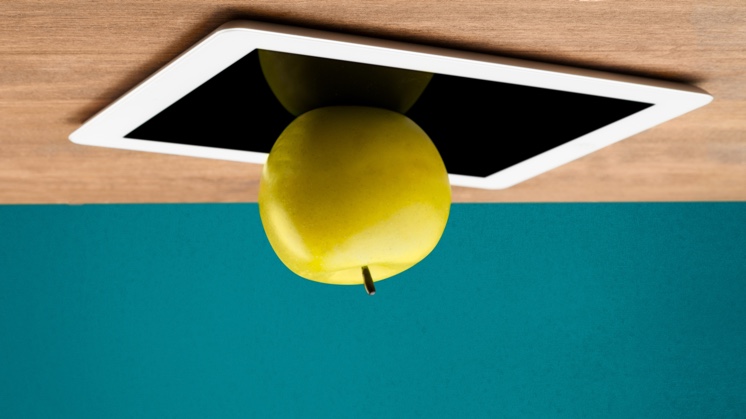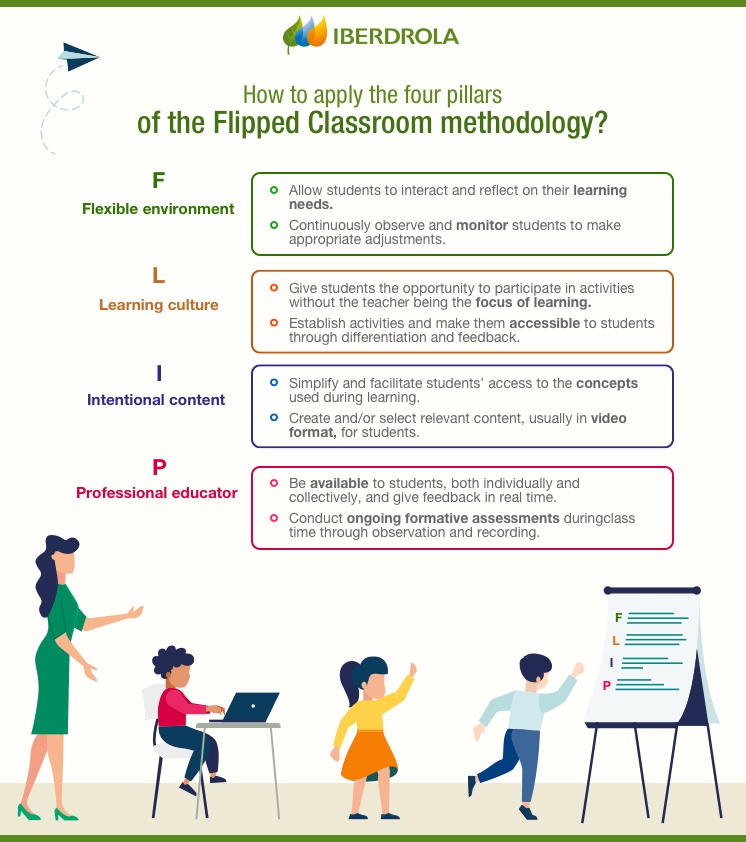Flipped classroom
Flipped classroom: a methodology to transform learning
Society High performance Internet Training
The flipped classroom pedagogical model, also known as the inverted classroom, has been gaining relevance in recent years due to the need to change the traditional learning system to adapt it to the new generations. The key to its proposal is that the student prepares the lessons (theoretical part) outside the classroom and carries out the activities (practical part) in the classroom.

Education, hand in hand with new technologies, has changed a lot and very quickly in recent years, hence the emergence of disruptive methodologies that seek to combine the best of the traditional (analogue) and modern (digital) worlds. One of these is the flipped classroom methodology, which proposes a 180º turnaround, turning the tables and removing certain tasks from the classroom in order to integrate others that are more relevant to learning.
What is flipped classroom
Like so many other educational innovations, such as blended learning or gamification, the flipped classroom emerged in the United States in 2007, when two teachers, Jonathan Bergman and Aarom Sams, began to record video explanations for students who, for various reasons, were unable to attend class. The experience was so positive that the system became so popular that it became a methodology with its own identity.
Since then, according to the Flipped Learning Network, a global reference organisation in this field, this model is defined as a pedagogical approach in which "direct instruction moves from the group learning space to the individual learning space, and the resulting group space is transformed into a dynamic, interactive learning environment where the educator guides students as they apply concepts and engage creatively with the subject matter".
In other words, while traditional learning is based on the maxim that the student learns in class and practices at home, the flipped classroom reverses the terms: the student studies the theory at home and practices what they have learned in class, always interacting with ICT and working collaboratively. In this way, time in the classroom is optimised and the teacher can dedicate it to reinforcing concepts, resolving doubts, working as a team and attending to each student's needs in a personalised way.
The flipped classroom methodology
Each of the initials of the word FLIP represents a pillar of the flipped classroom methodology:
- F: Flexible environment
Teachers create adaptable spaces and students choose where and when they learn. This flexibility affects not only learning times and places, but also teacher expectations and student assessments.
- L: Learning culture
The focus of learning shifts from the teacher to the learner, transforming the learning culture. Class time is dedicated to deepening the subject matter, resolving possible doubts and engaging in more enriching learning activities.
- I: Intentional content
Flipped learning educators think and create content with a clear intention: to maximise classroom time, aiming for procedural fluency, to focus on students and the development of their conceptual understanding.
- P: Professional educator
The flipped classroom requires committed teachers who observe their students, giving them feedback and evaluating them at all times. Their role in the classroom must be less prominent and they seek to connect with peers to improve their practice and share procedures.

SEE INFOGRAPHIC: How to apply the four pillars of the flipped classroom methodology? [PDF]
Advantages of the flipped classroom
The University of Toronto External link, opens in new window. cites some of the advantages of the flipped classroom in an article on pedagogy:
External link, opens in new window. cites some of the advantages of the flipped classroom in an article on pedagogy:
Efficient use of class time
The content, in the form of videos, can be viewed outside the classroom. In this way, traditional passive learning takes place outside the classroom and class time is freed up to increase student participation and interaction.
Pre-eminence of active learning
When the traditionally passive reading component is taken out of the classroom, the classroom has the potential to become a workshop that incorporates and focuses on active learning. Thus, the classroom becomes a central component rather than an adjunct.
Increased interactions
The freed-up class time allows for more interaction between teachers and students, and among the students themselves. There is also more time for extended classroom discussions and exercises. This allows for interaction with concepts, learning materials and peers in the classroom.
Increased responsibility
Students should come to class prepared, which increases their responsibility in their daily life and, specifically, for their learning. In a way, this also makes it easier for the student to direct his or her own learning.
Multiple learning styles
The flipped classroom supports diversity in students' learning and allows them additional time to review materials. In addition, they can reflect and experiment through questions and discussions with their peers to solve problems.
Roles in the flipped classroom methodology
After all that has been analysed, it is clear that the flipped classroom methodology greatly transforms the role of the different actors involved in learning. In the following, we review it in detail:
- Teacher. Like the classroom itself, the role of the teacher is also inverted. The idea is to stop being the owner of knowledge and become a facilitator of learning. Among his or her competences as a guide are to detect students' potential, to encourage teamwork, to monitor each student and, as far as he or she is concerned, to train continuously, to be connected with other teachers in order to improve every day and to accept constructive criticism.
- Student. They become the protagonist of their own learning, acquiring an active, autonomous and collaborative role from the very beginning. In fact, they can choose the type of material that best suits their way of learning and work at their own pace.
- Family. Their role is fundamental, especially at the earliest ages, as they are the ones who will have to integrate this new way of learning at home and make their children understand it. In these cases, teacher-family communication is fundamental.
Flipped classroom tools
ICT plays a key role in the flipped classroom, as it is only through ICT that the model can be developed. A flipped classroom does not appear overnight, it is necessary to plan it in detail and to have the necessary tools. In this sense, in addition to the well-known Google tools (Classroom, Meet, Forms, Drive, etc.), there are other specific tools for creating, organising and disseminating content:
- Genially. It offers multiple possibilities for creating content: presentations, infographics or educational games. It also allows collaborative work.
- Test Teach. This is a platform for organising educational content (videos, images, files, etc.) and sharing them with students.
- EDpuzzle. An application that allows you to enrich videos from YouTube or any other platform, whether your own or from third parties, by adding text or voice comments, questions or quizzes.
- Socrative. It allows teachers to test the knowledge of each student and to make reports on the level of the class, at the same time boosting gamification.
- ShowMe Interactive Whiteboard. A tool for recording audio tutorials on a whiteboard image and sharing them online, both communally and privately.




